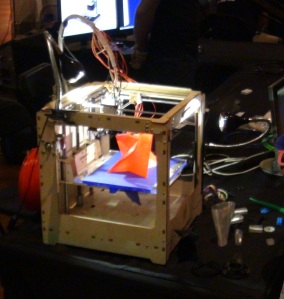The Maker Faire at the Henry Ford (Museum*) in Dearborn, Michigan, a couple of weekends ago was, as usual, a complete blast, and not just because there was a gigantic “draggin’ truck” attending.
If you’ve never been to a maker faire, especially a big regional one like the one at the Henry Ford, you have missed a lot of fun, not to mention the sight of a huge group of people of all ages having more fun than you’ve ever seen before.
I was fortunate enough to have the chance to spend the afternoon with my friends of the Illuminatus Light Show demonstrating and explaining inexpensive laser light show equipment to people of all ages, which was a blast in itself, but the wild things going on everywhere inside and outside the museum were highly entertaining, too. Robots of every size and description, crazy looking multi-rider bicycles, and amazing costumes and contraptions were everywhere, being demonstrated and with their inner workings exposed to all. There were a lot of people learning how to solder and construct and program their ideas into a technological form. That was all great, but there was also a LOT of a most striking current-and-future technology: 3D printing.
In the past year or two I noticed that 3D printing had come within the cost range of the dedicated basement inventor. As with a lot of early-stage technologies, there is a lot of novelty in the things people are doing, in some part driven by the relatively limited list of materials that can be printed. For instance, I know a young female engineer who, with her fiancé, printed their engagement rings on their own 3D printer. Clearly the “coolness” of making rings this way far transcends the fact that the rings are plastic – this is a technologically informed, 21st century relationship.
3D printing actually isn’t that new. 3D printing began revolutionizing rapid prototype creation in the 80’s but, like many new technologies, its development has been slow. Perhaps its complexity has slowed acceptance and the development of inexpensive equipment has not been a priority to the early corporate developers, but it is starting to catch on with the home inventors now, and this was clearly visible in the many small objects printed at the Maker Faire, some of which were quite intricate and beautiful. This technology is only beginning to be used to produce common, usable objects – the much-storied plastic gun and bullets being an example – but it will be interesting to see what becomes practical and cost-effective for 3D printing applications next. So what is in the future for 3D printing?
As usual with most new technologies, the “cutting edge” concepts were established a long time ago. In more than one early science fiction stories authors described a box, similar in description to today’s microwave oven, on which one could set controls to produce anything one needed. The magic box would produce food, clothing, shoes, tools or anything else that would fit inside it. The parallel in 3D printing is obvious. It appears the big advances in 3D printing from here will center on diversifying and improving materials and material handling and, to a lesser degree, scaling to create larger and smaller objects.
Millions of hours of development work will be involved over the coming decades, both to extend the methods to more materials and to create flexible 3D printers that can mix or change materials on the fly. A lot of ingredients and processing might be needed to print most foods, for example. New corporations will emerge to sell and service 3D printing equipment, and some may achieve dominant positions and become the AT&T’s, IBM’s, and Microsofts of their day.
The creation of 3D printing at much smaller and larger scales is probable. If it isn’t available already, it won’t be long until a 3D printer can be scaled to print objects ranging from microscopic electronic components to entire buildings. Imagine a huge 3D printer, a block square, built to work simultaneously in steel, concrete, pvc, glass, and copper, that can essentially excrete a skyscraper. You would just let it run and keep feeding it until it hit the target height for the building, and then stop it and change the programming to finish off the top. Then it would be disassembled similarly to other construction equipment today and trucked off to be re-used on another site. Of course, to build a skyscraper it would need an adjacent city block dedicated to feeding materials into the site and a nearby rail spur and/or its own freeway connection, but it seems conceivable.
Is “3D matter printing” possible? Perhaps in a century or two we will be possible to convert matter from one form to another at a molecular level, enabling 3D matter printers that will truly be able to create any material. Such a technology might require too much energy, however, to be used except in laboratories or extreme situations where what was being created had an extremely high value and no other means is available. Until then I’m betting that the field will look pretty much like an extension and diversification of what we have today. How far the technology can go while remaining increasingly cost-effective remains to be seen, but this could be a big part of business and life in general in a few decades, and the Make crowd may play a big part in its development.
As always, I welcome your comments.


Pingback: 3D Printing Could Revolutionize Drugs | Talesfromthelou's Blog
And there you have molecular-scale printing! Awesome and thank you for sharing that. Anyone else see something related and interesting?
Hard to write about Futuring when the President announces he will by pass the Law of the Land – the Constitution – in order to do whatever he wants. Don’t the Democrats clapping for that dictator-wanna-be understand that they will be the first ones marched out and shot if he ever does get his way?? Its happened every time to everyone who put a dictator in office. But alas, liberals don’t look at facts – or they would not be liberals in the 1st place
I didn’t miss anything, Nik, but I think your views are naive and simplistic. And you missed my point, Nik: the governments are mostly doing what corporations lobby, manipulate, and pay for. That can be expected given the heavy presence of ex-corporate people, mostly lawyers, in government. If making war makes money, some corporations will inevitably invest in the political channels that make wars, and some will be successful at creating and sustaining them.
As to your last question, it is not governments, corporations, or individuals that provide products and services, it is the horrendously complicated systems we have constructed from those things to satisfy our needs. Those systems need to be understood and worked with AS systems to make any meaningful change. Allowing any one element of a system to have power not allowed for in the system’s design unbalances the system, and the results are less good than they might be, and possibly disastrous. When corporations have so much more money and power than governments, let alone individuals, those with the least power will suffer the most.
Corporations will naturally hide their influence, of course, since some of us complain about conflicts of interest and lack of fairness in economic systems, but they can afford huge sums and hide a lot.
Your attack of the government may, in itself, be a product of ideas promoted by corporate-paid pundits intended to convince people to reduce the government’s ability to regulate business. They can also manipulate racists to hate Obama, for example, and manipulate others in similar ways to achieve their ends, a government that will let them do what they want regardless if their actions end up killing millions. Corporations are big machines, made of concepts and willing people, but with their own internal motivations and often the power to do terrible things unless something stops them, and what other thing can reliably limit their power and make sure they don’t kill or cause the deaths of more people? Government. Have you got a better candidate?
i could invert what you say politically,. Nik, and then I would believe it. I am sorry the conservative billionaires who love fascism, like Rupert Murdoch, have convinced you to help them destroy American democracy so they can make more money.